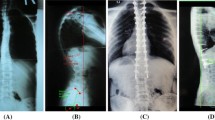Abstract
Purpose
Distal junctional kyphosis (DJK) is a major instrumentation-related complication after the surgical correction of Scheuermann kyphosis (SK). The exact criteria to avoid DJK have been controversial. It has been recommended to include the SSV into the fusion by some authors, while others suggest that fusion to FLV is sufficient. The purpose of this study was to investigate the occurrence of DJK in relation to distal fusion level selection in SK surgery by investigating the relationship between the sagittal stable vertebra (SSV), first lordotic vertebra (FLV), and the lowest instrumented vertebra (LIV).
Methods
54 patients (mean age: 21.2 years, range 12–43; male/female: 20/34) with SK who were treated by posterior segmental instrumentation and fusion were prospectively evaluated. Patients were allocated into 3 groups according to distal fusion level. In group 1, SSV was chosen as LIV (n = 20), and in group 2, LIV was the FLV (n = 16). Third group consisted of 18 patients in whom SSV and FLV was the same vertebra. Distal junctional angle, sagittal plane analysis, and clinical outcomes according to SF-36 were evaluated.
Results
Mean preoperative kyphosis angles were 77.2°, 73.4°, and 76.7° in groups 1, 2, and 3, respectively (p = 0.281), which decreased to 38.1°, 37.3°, and 37.8° postoperatively at final follow-up (p = 0.988). Mean follow-up time was 28.3 months. Correction amounts were similar between the groups (p = 0.409). 3 patients in SSV group, 5 patients in FLV group, and 3 patients in SSV-FLV group developed DJK, which was statistically insignificant. The C7 sagittal plumbline, lumbar lordosis, and pelvic parameters were not significantly different before or after surgery between the groups. Preoperative and postoperative results of SF-36 questionnaire were similar in all the groups. None of the patients who had DJK required revision surgery during the follow-up time.
Conclusion
Proper selection of distal fusion level is important in order to prevent DJK after SK surgery. According to this study, it is not necessary to extend the fusion down to the SSV. Fusion to FLV is sufficient and saves a level.


Similar content being viewed by others
References
Lowe TG (1990) Current concepts review, Scheuermann disease. J Bone Joint Surg Am 72:940–945
Hosman AJ, Langeloo DD, de Kleuver M, Anderson PG, Veth RP, Slot GH (2002) Analysis of the sagittal plane after surgical management for Scheuermann disease. A view on over correction and the use of an anterior release. Spine (Phila Pa 1976) 27:167–75
Coe JD, Smith JS, Berven S, Arlet V, Donaldson W, Hanson D, Mudiyam R, Perra J, Owen J, Marks MC, Shaffrey CI (2010) Complications of spinal fusion for Scheuermann kyphosis: a report of the scoliosis research society morbidity and mortality committee. Spine (Phila Pa 1976) 35(1):99–103. doi:10.1097/BRS.0b013e3181c47f0f
Denis F, Sun EC, Winter RB (2009) Incidence and risk factors for proximal and distal junctional kyphosis following surgical treatment for Scheuermann kyphosis: minimum five-year follow-up. Spine (Phila Pa 1976) 34(20):E729–34. doi:10.1097/BRS.0b013e3181ae2ab2
Lowe TG, Kasten MD (1994) An analysis of sagittal curves and balance after Cotrel-Dubousset instrumentation for kyphosis secondary to Scheuermann’s disease. A review of 32 patients. Spine (Phila Pa 1976) 19(15):1680–85
Wenger DR, Frick SL (1999) Scheuermann kyphosis. Spine (Phila Pa 1976) 24(24):2630–39
Cho KJ, Lenke LG, Bridwell KH, Kamiya M, Sides B (2009) Selection of the optimal distal fusion level in posterior instrumentation and fusion for thoracic hyperkyphosis: the sagittal stable vertebra concept. Spine (Phila Pa 1976) 34(8):765–70. doi:10.1097/BRS.0b013e31819e28ed
Lowe TG, Lenke L, Betz R, Newton P, Clements D, Haher T, Crawford A, Letko L, Wilson LA (2006) Distal junctional kyphosis of adolescent idiopathic thoracic curves following anterior or posterior instrumented fusion: incidence, risk factors, and prevention. Spine (Phila Pa 1976) 31(3):299–302
Arlet V, Aebi M (2013) Junctional spinal disorders in operated adult spinal deformities: present understanding and future perspectives. Review article. Eur Spine J 22 (Suppl 2):276–95. doi:10.1007/s00586-013-2676-x
Lundline K, Turner P, Johnson M (2012) Thoracic hyperkyphosis: assessment of the distal fusion level. Global Spine J 2:65–70. doi:10.1055/s-0032-1319771
O’Brien MF, Kuklon TR, Blanke KM et al (2004) Spinal Deformity Study Group Radiographic Measurement Manual. Medtronic Sofamor Danek, Memphis
Lowe TG (2007) Scheuermann’s kyphosis. Neurosurg Clin N Am 18:305–315
Lonner BS, Newton P, Betz R Scharf C, O’Brien M, Sponseller P, Lenke L, Crawford A, Lowe T, Letko L, Harms J, Shufflebarger H (2007) Operative management of Scheuermann’s kyphosis in 78 patients. Radiographic outcomes, complications, and technique. Spine (Phila Pa 1976) 32(24):2644–52
Koptan WM, Elmiligui YH, Elsebaie HB (2009) All pedicle screw instrumentation for Scheuermann’s kyphosis correction: is it worth it? Spine J 9(4):296–302. doi:10.1016/j.spinee.2008.05.011
Lee SS, Lenke LG, Kuklo TR, Valenté L, Bridwell KH, Sides B, Blanke KM (2006) Comparison of Scheuermann kyphosis correction by posterior-only thoracic pedicle screw fixation versus combined anterior/posterior fusion. Spine (Phila Pa 1976) 31:2316–21
Jansen RC, Van Rhijn LW, Van Ooij A (2006) Predictable correction of the unfused lumbar lordosis after the thoracic correction and fusion in Scheuermann kyphosis. Spine (Phila Pa 1976) 31(11):1227–31
Acknowledgement
No funds were received in support of this work. No benefits in any form have been or will be received from a commercial party related directly or indirectly to the subject of this manuscript.
Author information
Authors and Affiliations
Corresponding author
Ethics declarations
The study is done under the permission of Haydarpasa Numune Education and Research Hospital Ethics Committee.
Conflict of interest
No benefits in any form have been or will be received from a commercial party related directly or indirectly to the subject of this manuscript.
Rights and permissions
About this article
Cite this article
Yanik, H.S., Ketenci, I.E., Coskun, T. et al. Selection of distal fusion level in posterior instrumentation and fusion of Scheuermann kyphosis: is fusion to sagittal stable vertebra necessary?. Eur Spine J 25, 583–589 (2016). https://doi.org/10.1007/s00586-015-4123-7
Received:
Revised:
Accepted:
Published:
Issue Date:
DOI: https://doi.org/10.1007/s00586-015-4123-7




